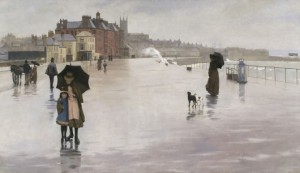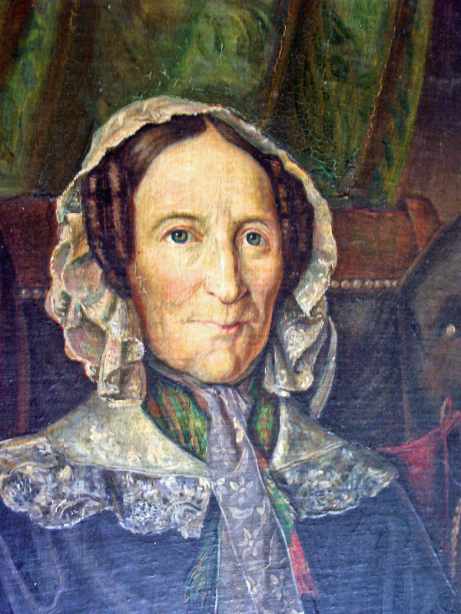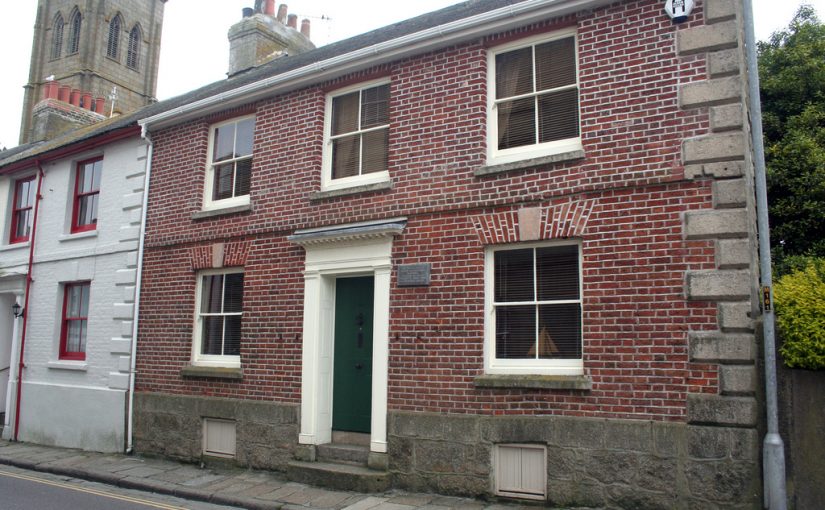Anne Brontë was just one and a half years old when her mother Maria died in Haworth, becoming just a name that Anne would carry around rather than a memory. Over the years her eldest sister, also called Maria, and then Charlotte would become mother like figures, but there was one woman above all else who filled that void in her life: Elizabeth Branwell, forever known as Aunt Branwell. In this and the next of our Anne Brontë blogs, I’ll be taking a look at this complex woman and her relationship with the Brontës. It may be different to the image that many people have.
Anne’s mother Maria was the eight child from eleven from the large and relatively wealth Branwell family of Penzance, Cornwall. Her father Thomas Branwell was a successful merchant and prominent in the politics of the area, but after he and his wife Anne Branwell (formerly Carne) died within a few years of each other, the family began to disperse from their Cornish origins. The picture at the top of this post is of the Branwell family home in Penzance.
Maria followed her Aunt Jane to Yorkshire, where she fell in love with the local clergyman Patrick Brontë. They had six children, and looking after them all must have been a struggle, but she did receive help in those early days – from her sister Elizabeth.
Elizabeth Branwell was born in 1776, making her seven years older than Maria. After the death of her parents, Elizabeth was left with an annuity of fifty pounds per year – a significant sum whose economic worth (rather than simply looking at the inflation figures) equates to around £60,000 per annum today. She would have been a central figure at balls and dinners across Cornwall, and yet she never married.

In 1815 she travelled to Thornton near Bradford to help her sister Maria look after her young family. In total she remained there for around a year before returning to Penzance, but she was soon to be back with the Brontë family again.
Shortly after moving to Haworth in 1820, just after the birth of their youngest daughter Anne, Mrs. Brontë fell gravely ill. It is often thought she had uterine cancer, although in 1972 Professor Philip Rhodes, one of the United Kingdom’s leading obstetricians and gynaecologists, said that the evidence ruled that out as a possible cause of death, and stated that chronic pelvic sepsis with anaemia was the likely cause.
As Maria became increasingly ill and unable to look after her children, her sister Elizabeth once again stepped up to the plate. She arrived in Haworth in the summer of 1821, and she was never to leave there until her own death twenty one years later.
In some ways this was a great sacrifice for Elizabeth: she had left a town where she was well known and well regarded, a town with genteel entertainments and a beautiful climate, and swapped it for a hillside village where the weather could be dreary, wild and unpredictable. Elizabeth found herself an outsider among people who neither looked like her, nor spoke like her.
She was also, in effect, shutting off her hopes of being married for ever, but did she harbour such thoughts anyway? She was by this time in her mid forties, and she had already seen what marriage and childbirth could do to her beloved sister Maria. As an alternative view, she may have been glad to have the opportunity to look after and raise children that would otherwise have been denied to her, although not of course of the circumstances that had brought this about.
Elizabeth Branwell was soon firmly part of the Haworth Parsonage fixtures, and became known as Aunt Branwell to the six young children she would care for. How did she treat the children, and how did they treat her? It’s an intriguing question, and like much of the Brontë story, there isn’t a huge amount of evidence. What we do have has created contrasting views of Aunt Branwell.
It is commonly thought that Aunt Branwell was a stern, rather humourless woman, who resented being trapped in what had become the prison of the parsonage. She was cold and clinical with the Brontë children, and a strict disciplinarian. Whilst there may be some elements of the truth in this, I can’t believe that this is a wholly fair picture of the woman who put her personal ambitions aside and diligently acted as a surrogate mother to the Brontës until the day of her death.

One view above all else has prevailed when it comes to Aunt Branwell, and it was supplied by Elizabeth Gaskell in her biography of her friend Charlotte Brontë:
‘Miss Branwell was, I believe, a kindly and conscientious woman, with a good deal of character, but with the somewhat narrow ideas natural to one who had spent nearly all her life in the same place. She had strong prejudices, and soon took a distaste to Yorkshire.’
We have another abiding description of her, this time from Ellen Nussey’s first visit to the Brontë home in 1833:
‘Miss Branwell was a very small, antiquated little lady. She wore caps large enough for half a dozen of the present fashion, and in front of light auburn curls over her forehead. She always dressed in silk. She had a horror of the climate so far north, and of the stone floors in the parsonage… She talked a great deal of her younger days… she gave one the idea that she had been a belle among her home acquaintances. She took snuff out of a very pretty gold snuff-box, which she sometimes presented to you with a little laugh, as if she enjoyed the slight shock and astonishment visible in your countenance… She and Mr Brontë had often to finish their discussions on what she had read when we all met for tea. She would be very lively and intelligent, and tilt arguments against Mr Brontë without fear.’
These descriptions are often used to present an Aunt Branwell that is unremittingly stern, with an archaic dress sense from which must follow archaic views on everything else. If we take a closer look, however, we can get a rather different picture.
Elizabeth Gaskell never knew Elizabeth Branwell, and so her views of her are second hand (and presumably based upon what Charlotte had told her of her aunt). Even here, however, we see her described as being ‘kindly and conscientious’.
Ellen too gives a rather different portrait of Aunt Branwell to the one most people have. She likes to laugh and enjoys a joke, she even enjoys shocking people by taking snuff. She may dress in an old fashioned way, but she also enjoys the pretty things in life – as evidenced by her gold snuff box and the collection of jewellery that we know she treasured.
If we take these two views perhaps we get a truer picture of Aunt Elizabeth Branwell: she disliked the cold climate of the north, her fashion was rather out of date, but she was kind, she had a sense of humour, and above all she was bright and intelligent.
All of these attributes could also, to a greater or lesser extent, be conferred upon the Brontës: and is that any wonder, when it was she who raised them just as a mother would. In next week’s blog we’ll take a further look at Aunt Branwell, by looking at perhaps the most pertinent evidence of them all: the views of the Brontë siblings themselves.
We’ll see how Aunt Branwell held a very special place for one special Brontë, and how she influenced her life and her work. Again it was hinted at by Ellen when in her description of Anne Brontë she says:
‘Anne, dear gentle Anne, was quite different in appearance from the others. She was her aunt’s favourite.’

What lovely insite to their lives
Thank you Fay!